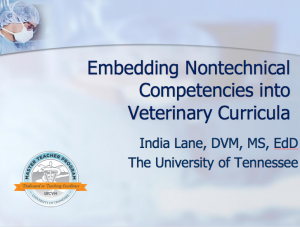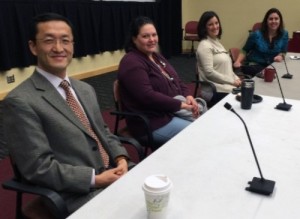During “Designing Course Experiences that Work for Everyone,” Jay Hsiao introduced small steps to make course materials more accessible for students regardless of abilities. View the presentation here.
Teaching: Course Design
Learning Outcomes Basics
Whether we’re presenting an introductory lecture to first-year DVM students, developing clinical skills in third-year students, guiding a discussion on hiring practices, or providing technology training to staff, LEARNING OUTCOMES enhance the experience for all involved.
According to the National Institute for Learning Outcomes Assessment, learning outcomes “clearly state the expected knowledge, skills, attitudes, competencies, and habits of mind that students are expected to acquire.”
In practice, learning outcomes provide the opportunity to specifically identify what learners should be able to do or to know as a result of activity we’ve planned. Moreover, making outcomes transparent ensures all involved in a learning experience commit resources toward the task at hand. (As a student or participant, if I don’t know what someone is trying to teach me or what they want me to do with this information, how can I assist or hold myself responsible?) Continue reading Learning Outcomes Basics
Visiting Expert Presents Innovative Approaches to Teaching Non-Technical Skills
 On Friday, Jan. 29, Dr. India Lane, Professor of Medicine in the Department of Small Animal Clinical Sciences and Associate Vice President for Academic Affairs and Student Success at the University of Tennessee, visited with faculty to discuss methods of teaching non-technical skills across a veterinary education curriculum.
On Friday, Jan. 29, Dr. India Lane, Professor of Medicine in the Department of Small Animal Clinical Sciences and Associate Vice President for Academic Affairs and Student Success at the University of Tennessee, visited with faculty to discuss methods of teaching non-technical skills across a veterinary education curriculum.
According to Dr. Lane, the following non-technical competencies have been identified as critical to successful veterinarians. Continue reading Visiting Expert Presents Innovative Approaches to Teaching Non-Technical Skills
2015 Exemplary Teaching Panel
Being a great teacher involves engaging with those who do it well. The following tips are condensed from the 2015 Exemplary Teaching Panel, which featured College of Veterinary Medicine faculty who earned recognition in 2015 as outstanding educators. Continue reading 2015 Exemplary Teaching Panel
How to Use Interactive Lecture Systems
 Several faculty at the College of Veterinary Medicine use clickers to bring a level of engagement and interactivity to large lecture courses. During the spring semester, you’ll hear the Office of Teaching & Learning introduce an eLearning tool that allows students to use mobile devices (phones, tablets, iPads) and computers as clickers. This web-based platform, available across OSU, is called TopHat.
Several faculty at the College of Veterinary Medicine use clickers to bring a level of engagement and interactivity to large lecture courses. During the spring semester, you’ll hear the Office of Teaching & Learning introduce an eLearning tool that allows students to use mobile devices (phones, tablets, iPads) and computers as clickers. This web-based platform, available across OSU, is called TopHat.
The value of clickers and TopHat includes: Continue reading How to Use Interactive Lecture Systems
How Learning Works
Beginning this spring, the Office of Teaching & Learning invites you to participate in a book group focusing on best practices and pedagogy. This Friday’s Tips include bits of advice from each of the chapters comprising our featured book, How Learning Works: 7 Research-Based Principles for Smart Teaching, by Susan A. Ambrose and colleagues. Continue reading How Learning Works
Teach for Application, Not Acquisition, Tech Leader Urges
“Most assignments were written before the internet,” according to Alan November, an international leader in educational technology who spoke this week to OSU faculty and staff on “Who Owns Learning?”
November challenged attendees to reconsider the way they teach and the way they think about how students learn. Highlights of his presentation can be summed up in the following tips. Continue reading Teach for Application, Not Acquisition, Tech Leader Urges



